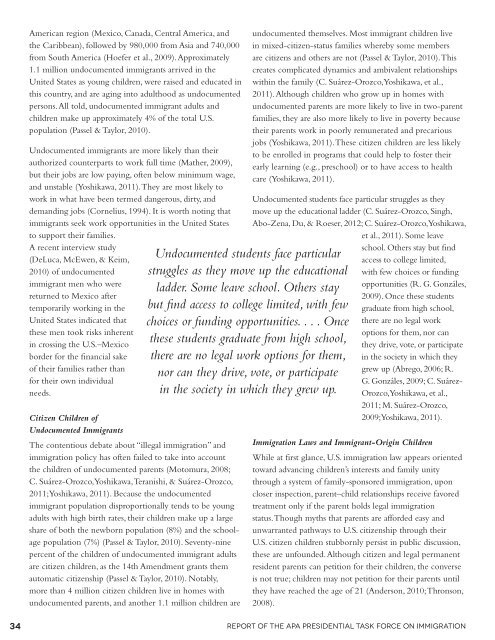Crossroads: The Psychology of Immigration in the New Century
Crossroads: The Psychology of Immigration in the New Century
Crossroads: The Psychology of Immigration in the New Century
You also want an ePaper? Increase the reach of your titles
YUMPU automatically turns print PDFs into web optimized ePapers that Google loves.
American region (Mexico, Canada, Central America, and<br />
<strong>the</strong> Caribbean), followed by 980,000 from Asia and 740,000<br />
from South America (Hoefer et al., 2009). Approximately<br />
1.1 million undocumented immigrants arrived <strong>in</strong> <strong>the</strong><br />
United States as young children, were raised and educated <strong>in</strong><br />
this country, and are ag<strong>in</strong>g <strong>in</strong>to adulthood as undocumented<br />
persons. All told, undocumented immigrant adults and<br />
children make up approximately 4% <strong>of</strong> <strong>the</strong> total U.S.<br />
population (Passel & Taylor, 2010).<br />
Undocumented immigrants are more likely than <strong>the</strong>ir<br />
authorized counterparts to work full time (Ma<strong>the</strong>r, 2009),<br />
but <strong>the</strong>ir jobs are low pay<strong>in</strong>g, <strong>of</strong>ten below m<strong>in</strong>imum wage,<br />
and unstable (Yoshikawa, 2011). <strong>The</strong>y are most likely to<br />
work <strong>in</strong> what have been termed dangerous, dirty, and<br />
demand<strong>in</strong>g jobs (Cornelius, 1994). It is worth not<strong>in</strong>g that<br />
immigrants seek work opportunities <strong>in</strong> <strong>the</strong> United States<br />
to support <strong>the</strong>ir families.<br />
A recent <strong>in</strong>terview study<br />
(DeLuca, McEwen, & Keim,<br />
2010) <strong>of</strong> undocumented<br />
immigrant men who were<br />
returned to Mexico after<br />
temporarily work<strong>in</strong>g <strong>in</strong> <strong>the</strong><br />
United States <strong>in</strong>dicated that<br />
<strong>the</strong>se men took risks <strong>in</strong>herent<br />
<strong>in</strong> cross<strong>in</strong>g <strong>the</strong> U.S.–Mexico<br />
border for <strong>the</strong> f<strong>in</strong>ancial sake<br />
<strong>of</strong> <strong>the</strong>ir families ra<strong>the</strong>r than<br />
for <strong>the</strong>ir own <strong>in</strong>dividual<br />
needs.<br />
Citizen Children <strong>of</strong><br />
Undocumented Immigrants<br />
<strong>The</strong> contentious debate about “illegal immigration” and<br />
immigration policy has <strong>of</strong>ten failed to take <strong>in</strong>to account<br />
<strong>the</strong> children <strong>of</strong> undocumented parents (Motomura, 2008;<br />
C. Suárez-Orozco, Yoshikawa, Teranishi, & Suárez-Orozco,<br />
2011; Yoshikawa, 2011). Because <strong>the</strong> undocumented<br />
immigrant population disproportionally tends to be young<br />
adults with high birth rates, <strong>the</strong>ir children make up a large<br />
share <strong>of</strong> both <strong>the</strong> newborn population (8%) and <strong>the</strong> schoolage<br />
population (7%) (Passel & Taylor, 2010). Seventy-n<strong>in</strong>e<br />
percent <strong>of</strong> <strong>the</strong> children <strong>of</strong> undocumented immigrant adults<br />
are citizen children, as <strong>the</strong> 14th Amendment grants <strong>the</strong>m<br />
automatic citizenship (Passel & Taylor, 2010). Notably,<br />
more than 4 million citizen children live <strong>in</strong> homes with<br />
undocumented parents, and ano<strong>the</strong>r 1.1 million children are<br />
Undocumented students face particular<br />
struggles as <strong>the</strong>y move up <strong>the</strong> educational<br />
ladder. Some leave school. O<strong>the</strong>rs stay<br />
but f<strong>in</strong>d access to college limited, with few<br />
choices or fund<strong>in</strong>g opportunities. . . . Once<br />
<strong>the</strong>se students graduate from high school,<br />
<strong>the</strong>re are no legal work options for <strong>the</strong>m,<br />
nor can <strong>the</strong>y drive, vote, or participate<br />
<strong>in</strong> <strong>the</strong> society <strong>in</strong> which <strong>the</strong>y grew up.<br />
undocumented <strong>the</strong>mselves. Most immigrant children live<br />
<strong>in</strong> mixed-citizen-status families whereby some members<br />
are citizens and o<strong>the</strong>rs are not (Passel & Taylor, 2010). This<br />
creates complicated dynamics and ambivalent relationships<br />
with<strong>in</strong> <strong>the</strong> family (C. Suárez-Orozco, Yoshikawa, et al.,<br />
2011). Although children who grow up <strong>in</strong> homes with<br />
undocumented parents are more likely to live <strong>in</strong> two-parent<br />
families, <strong>the</strong>y are also more likely to live <strong>in</strong> poverty because<br />
<strong>the</strong>ir parents work <strong>in</strong> poorly remunerated and precarious<br />
jobs (Yoshikawa, 2011). <strong>The</strong>se citizen children are less likely<br />
to be enrolled <strong>in</strong> programs that could help to foster <strong>the</strong>ir<br />
early learn<strong>in</strong>g (e.g., preschool) or to have access to health<br />
care (Yoshikawa, 2011).<br />
Undocumented students face particular struggles as <strong>the</strong>y<br />
move up <strong>the</strong> educational ladder (C. Suárez-Orozco, S<strong>in</strong>gh,<br />
Abo-Zena, Du, & Roeser, 2012; C. Suárez-Orozco, Yoshikawa,<br />
et al., 2011). Some leave<br />
school. O<strong>the</strong>rs stay but f<strong>in</strong>d<br />
access to college limited,<br />
with few choices or fund<strong>in</strong>g<br />
opportunities (R. G. Gonzáles,<br />
2009). Once <strong>the</strong>se students<br />
graduate from high school,<br />
<strong>the</strong>re are no legal work<br />
options for <strong>the</strong>m, nor can<br />
<strong>the</strong>y drive, vote, or participate<br />
<strong>in</strong> <strong>the</strong> society <strong>in</strong> which <strong>the</strong>y<br />
grew up (Abrego, 2006; R.<br />
G. Gonzáles, 2009; C. Suárez-<br />
Orozco, Yoshikawa, et al.,<br />
2011; M. Suárez-Orozco,<br />
2009; Yoshikawa, 2011).<br />
<strong>Immigration</strong> Laws and Immigrant-Orig<strong>in</strong> Children<br />
While at first glance, U.S. immigration law appears oriented<br />
toward advanc<strong>in</strong>g children’s <strong>in</strong>terests and family unity<br />
through a system <strong>of</strong> family-sponsored immigration, upon<br />
closer <strong>in</strong>spection, parent–child relationships receive favored<br />
treatment only if <strong>the</strong> parent holds legal immigration<br />
status. Though myths that parents are afforded easy and<br />
unwarranted pathways to U.S. citizenship through <strong>the</strong>ir<br />
U.S. citizen children stubbornly persist <strong>in</strong> public discussion,<br />
<strong>the</strong>se are unfounded. Although citizen and legal permanent<br />
resident parents can petition for <strong>the</strong>ir children, <strong>the</strong> converse<br />
is not true; children may not petition for <strong>the</strong>ir parents until<br />
<strong>the</strong>y have reached <strong>the</strong> age <strong>of</strong> 21 (Anderson, 2010; Thronson,<br />
2008).<br />
34 Report <strong>of</strong> <strong>the</strong> APA Presidential Task Force on <strong>Immigration</strong>
















